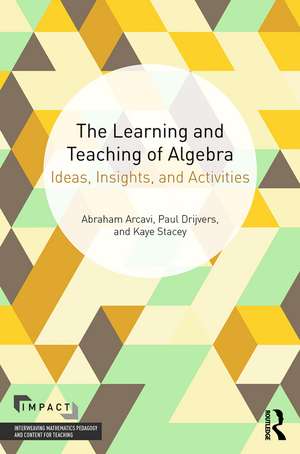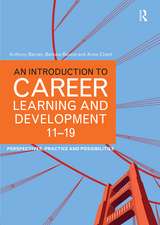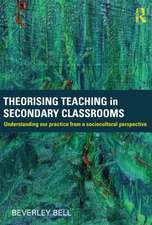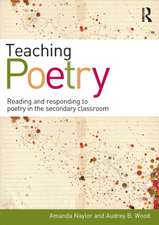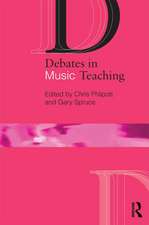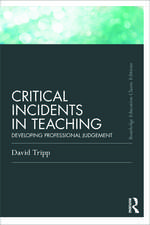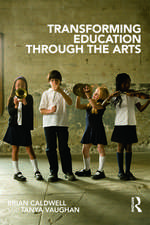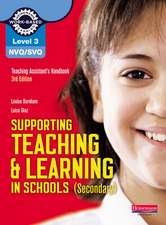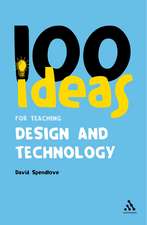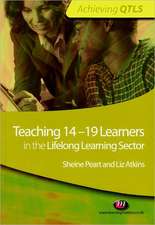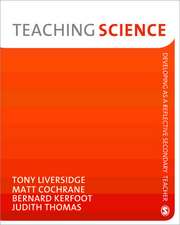The Learning and Teaching of Algebra: Ideas, Insights and Activities: IMPACT: Interweaving Mathematics Pedagogy and Content for Teaching
Autor Abraham Arcavi, Paul Drijvers, Kaye Staceyen Limba Engleză Paperback – iul 2016
The Learning and Teaching of Algebra provides a pedagogical framework for the teaching and learning of algebra grounded in theory and research.
Areas covered include:
• Algebra: Setting the Scene
• Some Lessons From History
• Seeing Algebra Through the Eyes of a Learner
• Emphases in Algebra Teaching
• Algebra Education in the Digital Era
This guide will be essential reading for trainee and qualified teachers of mathematics, graduate students, curriculum developers, researchers and all those who are interested in the "problématique" of teaching and learning algebra. It allows you to get involved in the wealth of knowledge that teachers can draw upon to assist learners, helping you gain the insights that mastering algebra provides.
| Toate formatele și edițiile | Preț | Express |
|---|---|---|
| Paperback (1) | 496.23 lei 6-8 săpt. | |
| Taylor & Francis – iul 2016 | 496.23 lei 6-8 săpt. | |
| Hardback (1) | 942.65 lei 6-8 săpt. | |
| Taylor & Francis – iul 2016 | 942.65 lei 6-8 săpt. |
Preț: 496.23 lei
Nou
Puncte Express: 744
Preț estimativ în valută:
94.95€ • 103.47$ • 80.01£
94.95€ • 103.47$ • 80.01£
Carte tipărită la comandă
Livrare economică 23 aprilie-07 mai
Preluare comenzi: 021 569.72.76
Specificații
ISBN-13: 9780415743723
ISBN-10: 0415743729
Pagini: 158
Ilustrații: 46
Dimensiuni: 156 x 234 x 12 mm
Greutate: 2.97 kg
Ediția:1
Editura: Taylor & Francis
Colecția Routledge
Seria IMPACT: Interweaving Mathematics Pedagogy and Content for Teaching
Locul publicării:Oxford, United Kingdom
ISBN-10: 0415743729
Pagini: 158
Ilustrații: 46
Dimensiuni: 156 x 234 x 12 mm
Greutate: 2.97 kg
Ediția:1
Editura: Taylor & Francis
Colecția Routledge
Seria IMPACT: Interweaving Mathematics Pedagogy and Content for Teaching
Locul publicării:Oxford, United Kingdom
Public țintă
Postgraduate and UndergraduateCuprins
Preface
1. Algebra – Setting the scene
1.1 Introduction
1.2 Algebra – Aims, actions and entities
1.2.1 Aims
1.2.2 Actions
1.2.3 Entities
1.3 Why Algebra?
1.4 Chapter Summary
1.5 Thinking further
1.6 References
2. Some lessons from history
2.1 Introduction
2.2 Linear equations in ancient Egypt
2.3 Quadratic equations in ancient Babylonia
2.4 A geometric view of algebra from Arabic mathematics
2.5 Beyond solving equations: The emergence of algebra in Europe
2.5.1 Some algebraic rules and their explanation
2.5.2 Negative numbers
2.6 Chapter summary
2.7 Thinking further
2.8 References
3. Seeing algebra through the eyes of a learner
3.1 Introduction – putting on teachers’ bifocal spectacles
3.2 What do algebraic letters represent?
3.2.1 Fruit salad algebra – misleading teaching with long term consequences
3.3 The process-object duality
3.4 The meaning of the equals sign
3.5 Algebra for recording and revealing mathematical structure
3.6 Transitions from arithmetic to algebra
3.6.1 Contrasting arithmetic and algebraic problem solving
3.6.2 Fundamental ideas of equation solving
3.6.3 Algebra and creativity
3.7 The procedures of equation solving
3.7.1 Process-object distinction in solving simultaneous equations
3.8 Functions as processes and objects
3.9 Chapter Summary
3.10 Thinking Further
3.11 References
Chapter 4: Emphases in algebra teaching
4.1 Introduction
4.2 Teaching algebra in context
4.3 Productive practice
4.4 The reconciliation of routine and insight
4.5 Exploiting student mistakes
4.6 Proofs in algebra teaching
4.7 Chapter summary
4.8 Thinking further
4.9 References
5. Algebra education in the digital era
5.1 Introduction
5.2 Digital tools for algebra
5.2.1 Algebraic functionality of digital tools
5.2.2 Pedagogical roles of digital tools for algebra
5.3 Core algebra entities with digital means
5.3.1 Variable
5.3.2 Equation and equivalence
5.3.3 Function
5.4 Teaching and learning algebra with digital means
5.5 Chapter summary
5.6 Thinking further
5.7 References
Epilogue
1. Algebra – Setting the scene
1.1 Introduction
1.2 Algebra – Aims, actions and entities
1.2.1 Aims
1.2.2 Actions
1.2.3 Entities
1.3 Why Algebra?
1.4 Chapter Summary
1.5 Thinking further
1.6 References
2. Some lessons from history
2.1 Introduction
2.2 Linear equations in ancient Egypt
2.3 Quadratic equations in ancient Babylonia
2.4 A geometric view of algebra from Arabic mathematics
2.5 Beyond solving equations: The emergence of algebra in Europe
2.5.1 Some algebraic rules and their explanation
2.5.2 Negative numbers
2.6 Chapter summary
2.7 Thinking further
2.8 References
3. Seeing algebra through the eyes of a learner
3.1 Introduction – putting on teachers’ bifocal spectacles
3.2 What do algebraic letters represent?
3.2.1 Fruit salad algebra – misleading teaching with long term consequences
3.3 The process-object duality
3.4 The meaning of the equals sign
3.5 Algebra for recording and revealing mathematical structure
3.6 Transitions from arithmetic to algebra
3.6.1 Contrasting arithmetic and algebraic problem solving
3.6.2 Fundamental ideas of equation solving
3.6.3 Algebra and creativity
3.7 The procedures of equation solving
3.7.1 Process-object distinction in solving simultaneous equations
3.8 Functions as processes and objects
3.9 Chapter Summary
3.10 Thinking Further
3.11 References
Chapter 4: Emphases in algebra teaching
4.1 Introduction
4.2 Teaching algebra in context
4.3 Productive practice
4.4 The reconciliation of routine and insight
4.5 Exploiting student mistakes
4.6 Proofs in algebra teaching
4.7 Chapter summary
4.8 Thinking further
4.9 References
5. Algebra education in the digital era
5.1 Introduction
5.2 Digital tools for algebra
5.2.1 Algebraic functionality of digital tools
5.2.2 Pedagogical roles of digital tools for algebra
5.3 Core algebra entities with digital means
5.3.1 Variable
5.3.2 Equation and equivalence
5.3.3 Function
5.4 Teaching and learning algebra with digital means
5.5 Chapter summary
5.6 Thinking further
5.7 References
Epilogue
Recenzii
"The book makes a valuable contribution to the existing literature in terms of the teaching and learning of algebra. At the same time it is different, in various ways: one of the differences is that it has been co-authored by three authors, rather than edited, which provides the reader with a more coherent reading."— Birgit Pepin, Nieuw Archief voor Wiskunde (Dutch Journal of the Royal Mathematics Society)
Descriere
The purpose of this book is to provide the reader with both a practical and research-informed introduction to the main issues in school algebra education which nowadays remains one of the core challenges of mathematics education in general. The book will enable readers to:
- identify and emphasize the big ideas of algebra;
- imbue teaching with a sense of purpose (why algebra? what is it for? In which ways does it empower to better understand real world situations and solve interesting problems?);
- understand how students think about algebra and design lessons accordingly;
- critically pursue assessment tools;
- use technology for algebra learning.
